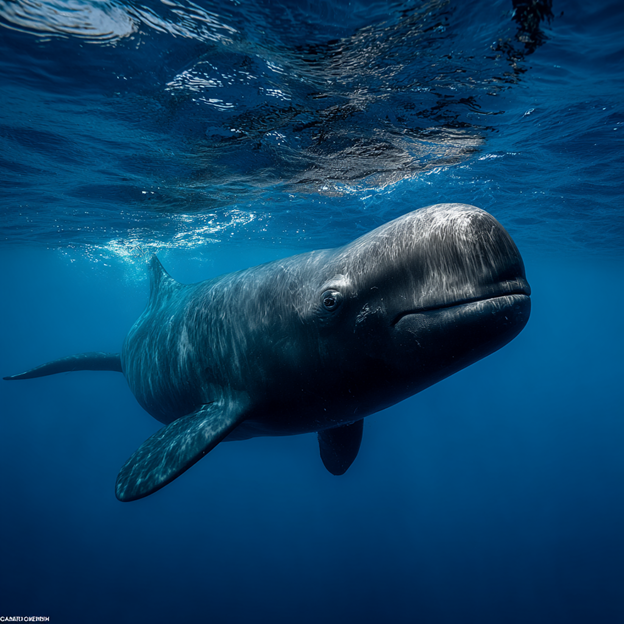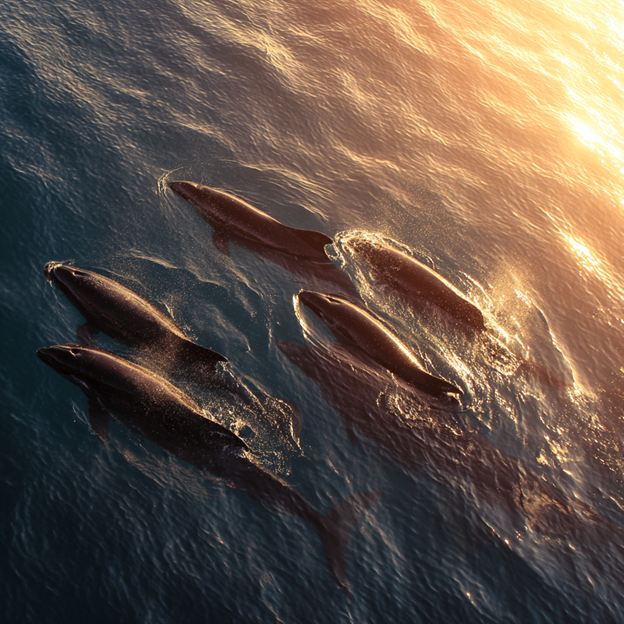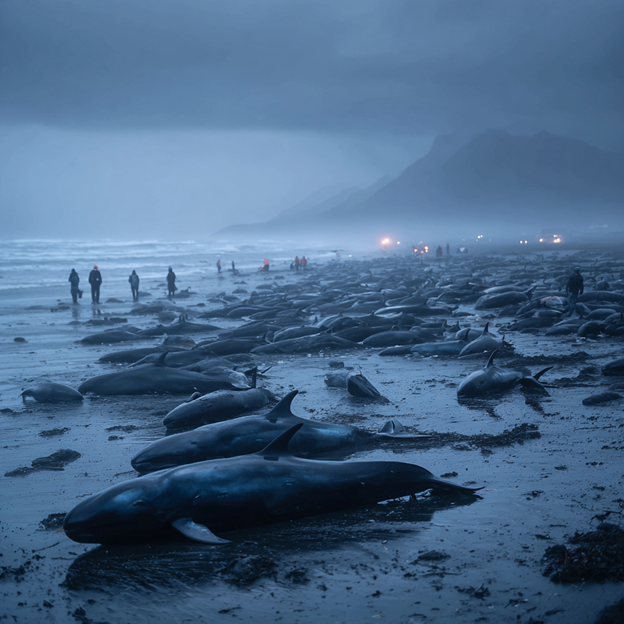As one of the largest members of the dolphin family, second only to the orca, the Pilot Whale's life is defined by unbreakable family bonds that guide its pods through the world's oceans. This intense social cohesion is the cornerstone of its existence, enabling cooperative hunting and communal care. Yet, this same loyalty is also its greatest vulnerability, making it susceptible to mass strandings and the brutal efficiency of traditional drive hunts.
This report delves into the dual nature of the Pilot Whale. It will begin with a scientific profile of the two distinct species, the long-finned and short-finned pilot whales. It will then explore the complex and controversial tradition of the grindadráp in the Faroe Islands, a practice rooted in centuries of subsistence but viewed globally with alarm. The report will also examine the enduring mystery of mass strandings, a phenomenon inextricably linked to the pilot whale's powerful social instincts. Finally, it will detail the current struggles these intelligent animals face, from direct hunts to the pervasive threats of a changing ocean.
The Central Paradox: Loyalty as Strength and Vulnerability
💪 Strength
Unbreakable family bonds enable cooperative hunting in the deep ocean. Pod members share knowledge, coordinate complex behaviors, and provide communal care for young and elderly. This social cohesion has allowed pilot whales to thrive as apex predators of the squid-rich waters.
💔 Vulnerability
The same bonds that create strength become deadly traps. When one whale strands, the entire pod follows, unable to abandon family. In drive hunts, their refusal to leave each other makes them easy targets. Loyalty unto death—literally.

The pilot whale's distinctive bulbous head and powerful form, belonging to a species defined by unbreakable, lifelong family bonds.
I. Biological Snapshot: A Scientific Profile
- Scientific Name / Genus: Genus Globicephala. Two species: Long-finned Pilot Whale (G. melas) and Short-finned Pilot Whale (G. macrorhynchus).
- Recognized Species & IUCN Status:
- Long-finned Pilot Whale (G. melas): Least Concern (globally), but Data Deficient in some regions.
- Short-finned Pilot Whale (G. macrorhynchus): Least Concern (globally), but Data Deficient in some regions.
- Physical Characteristics:
- Length: 4 to 7.6 m (13 to 25 ft). Males are significantly larger than females in both species.
- Weight: Long-finned: up to 2,300 kg (males); Short-finned: up to 3,200 kg (males).
- Lifespan: Males: ~45 years; Females: ~60 years for both species.
- Distinguishing Features: Robust, dark gray or black body with a distinctive large, bulbous forehead (melon). The dorsal fin is low, rounded, and set far forward on the back. The primary physical difference is the flipper length: one-fifth of body length in long-finned, one-sixth in short-finned.
- Global Population: Global population for both species is unknown but estimated to be over 1 million combined. Long-finned pilot whales are estimated at 700,000–1,000,000 and short-finned at 200,000–300,000.
- Distribution & Habitat: Nearly worldwide distribution. Long-finned pilot whales prefer colder, temperate, and subpolar waters, while short-finned pilot whales inhabit warmer tropical and subtropical waters. They are found in both coastal and deep offshore waters, often preferring areas with steep topography like the continental shelf edge.
- Diet & Foraging: Primarily squid and octopus (teuthophagous), supplemented with fish like mackerel, herring, and cod. They are deep divers, capable of reaching depths over 600m, and often hunt at night using echolocation to find prey.
- Reproduction:
- Gestation Period: 12 to 16 months
- Calf Size at Birth: ~2 meters long
- Sexual Maturity: Females: 6–9 years; Males: 12–17 years
- Calving Interval: A single calf is born every 3 to 8 years, one of the longest birth intervals among cetaceans.

A pod travels as one, their legendary social bonds enabling complex cooperation while also creating a profound vulnerability.
II. The Grindadráp: A Tradition of Communal Hunting
In the Faroe Islands, a remote archipelago in the North Atlantic, the relationship with the Long-finned Pilot Whale is defined by the grindadráp, or "the grind"—a traditional, non-commercial, and communal whale hunt. This practice is a deeply ingrained part of Faroese culture, providing a significant source of food for the community. However, the methods used and the scale of the hunts have made it the subject of intense international controversy.
The success of the grindadráp is predicated on the pilot whale's own intensely social nature. The hunts are opportunistic, beginning when a pod of pilot whales is spotted close to shore. A flotilla of small boats then works to herd the entire pod, exploiting their tight social bonds and reluctance to abandon one another. The whales are driven into a shallow, designated bay where they are slaughtered by hunters waiting in the water.
A Clash of Values
Two perspectives on a deeply controversial practice
Faroese Perspective
- A sustainable tradition practiced for centuries, integral to Faroese identity and cultural heritage
- Provides free, locally sourced meat, reducing reliance on environmentally costly imported foods
- A communal activity that reinforces social ties and connects the community to their ancestors
- The pilot whale population in the North Atlantic is not endangered, making the hunt sustainable
- A right to cultural self-determination and traditional subsistence practices
International Criticism
- The drive process causes extreme stress and suffering to highly intelligent, social animals
- Killing methods are considered brutal and inhumane by animal welfare organizations
- The number of animals killed in some hunts (sometimes hundreds at once) raises sustainability concerns
- Modern Faroe Islands has alternative food sources, making the practice unnecessary
- A global imperative to protect intelligent marine mammals from harm
The grindadráp thus represents a profound clash of values: a community's right to cultural self-determination and traditional subsistence versus a global call for the protection of intelligent, social marine mammals.

The tragic result of social loyalty: a mass stranding, where an entire pod follows a distressed member ashore, choosing family over survival.
III. The Mystery of Mass Strandings
Pilot whales are notorious for stranding themselves on beaches in large numbers, a tragic and perplexing behavior that has been documented for centuries. These mass stranding events are a direct and devastating consequence of the same powerful social cohesion that defines their lives. When one individual becomes sick, injured, or disoriented and heads for shore, the strong social bonds within the pod often compel the entire group to follow, leading to a collective tragedy.
The precise causes of these events are not fully understood, but several theories exist:
🧭 Navigational Errors
Pilot whales are deep-water animals that prefer areas with steep underwater topography, like the edge of the continental shelf. Their echolocation may not function as effectively in shallow, gently sloping coastal environments, potentially leading to navigational errors that trap them ashore.
👨✈️ Following a Sick Leader
The original theory behind their name was that each pod followed a single "pilot." If this leader becomes ill or disoriented, it may lead the entire pod into danger, with the rest following out of loyalty and social cohesion.
🦠 Parasitic Infections
Some scientists theorize that parasitic infections could interfere with the whales' central nervous systems, impairing their neurological function and ability to navigate, causing them to become disoriented and beach themselves.
🔊 Anthropogenic Noise
There is growing concern that intense underwater noise from sources like naval sonar or seismic surveys could disrupt the whales' behavior and navigation, contributing to strandings by overwhelming their sensory systems.
Regardless of the initial trigger, the outcome is often the same: a beach covered with dozens or even hundreds of whales, a stark and tragic testament to the power of their social loyalty.
IV. A Familiar's Struggle: Contemporary Threats
While the global populations of both pilot whale species are currently listed as "Least Concern" by the IUCN, this broad classification belies the significant and varied threats they face across their range. Their intelligence and social complexity do not protect them from the dangers of an increasingly industrialized ocean.
| Primary Threat | Direct Impact | Synergistic Effects & Cascading Impacts | Ultimate Consequence for Pilot Whale Population |
|---|---|---|---|
| Direct Hunts | Intentional killing in drive fisheries (e.g., Faroe Islands, Japan) for meat and other products. | Removes entire social units from the population; inflicts extreme stress and cruelty. | Unsustainable mortality in targeted regions; potential for local population depletion. |
| Fisheries Bycatch | Accidental entanglement and drowning in fishing gear such as trawls, long-lines, and driftnets. | Causes direct, unnatural mortality and serious injury. | A significant but often underreported source of death across their range. |
| Underwater Noise Pollution | Disruption of communication, navigation, and foraging from shipping, seismic surveys, and military sonar. | Masks echolocation signals, causing chronic stress, displacing whales from key habitats, and potentially contributing to mass strandings. | Reduced foraging success, abandonment of traditional habitats, and increased mortality. |
| Chemical & Plastic Pollution | Bioaccumulation of pollutants (heavy metals, PCBs) and ingestion of plastic debris. | Compromises immune systems, causes reproductive failure, and can lead to death from blockages or toxicity. | Reduced birth rates, increased disease susceptibility, and weakened overall population health. |
Connection to the South: Loyalty Beyond Reason
In the Medicine Wheel's South direction, the Pilot Whale embodies the deepest and most profound aspect of emotional life: loyalty that transcends self-preservation, bonds that persist beyond death, and the simultaneous beauty and tragedy of refusing to abandon those we love.
The pilot whale's story is a meditation on the nature of emotional attachment itself. Their pods are not loose associations but permanent family units where individuals remain together for life. Mothers stay with their daughters for decades. Post-reproductive females—grandmothers—play crucial roles in the pod's survival, sharing knowledge and guiding younger members. This is a society built on emotional bonds so strong they become existential commitments.
But the South also teaches us about the shadow side of these bonds. The pilot whale's strandings are not accidents—they are choices. When one whale beaches itself, whether from illness, disorientation, or injury, the pod faces a terrible decision. And time and again, they choose to follow. They choose loyalty over survival. They swim into shallow water, knowing they cannot swim out. They strand themselves on beaches where they will die, because to abandon a family member would be to betray something more fundamental than the instinct for self-preservation.
This is the paradox at the heart of emotional life: the very bonds that give meaning to existence can become the mechanism of our destruction. The pilot whale asks us to witness this paradox without looking away. To see that loyalty can be both the highest virtue and a fatal vulnerability. To understand that the same social cohesion that enables cooperative hunting and communal care also makes an entire pod vulnerable to a single member's distress.
The South's teaching through the pilot whale is uncomfortable: not all emotional truths are comforting. Sometimes love means following someone into danger. Sometimes loyalty means refusing to save yourself. Sometimes the bonds that define us are the same bonds that can destroy us. And yet—and this is crucial—the pilot whales persist. Despite millennia of strandings, despite the vulnerability created by their social nature, they have not evolved away from these bonds. The loyalty remains.
To honor the pilot whale is to acknowledge the full complexity of emotional life—not just the joy of connection but also the cost. It is to recognize that some beings would rather die together than live alone, and that this choice, however tragic, emerges from something we can only call love. The pilot whales teach us that the South is not about simple feelings but about the profound, often painful depths of emotional truth: that we are who we love, that our bonds define us more than our individuality, and that sometimes loyalty means choosing to stay even when staying means not surviving.
References
- NOAA Fisheries. Long-Finned Pilot Whale Species Profile. National Oceanic and Atmospheric Administration. https://www.fisheries.noaa.gov/species/long-finned-pilot-whale
- NOAA Fisheries. Short-Finned Pilot Whale Species Profile. National Oceanic and Atmospheric Administration. https://www.fisheries.noaa.gov/species/short-finned-pilot-whale
- Alves, F., Quérouil, S., Dinis, A., Nicolau, C., Ribeiro, C., Freitas, L., Kaufmann, M., & Fortuna, C. (2013). Population structure of short-finned pilot whales in the oceanic archipelago of Madeira based on photo-identification and genetic analyses: implications for conservation. Aquatic Conservation: Marine and Freshwater Ecosystems, 23(5), 758-776. https://onlinelibrary.wiley.com/doi/10.1002/aqc.2332
- Oremus, M., Gales, R., Kettles, H., & Baker, C. S. (2013). Genetic evidence of multiple matrilines and spatial disruption of kinship bonds in mass strandings of long-finned pilot whales, Globicephala melas. Journal of Heredity, 104(3), 301-311. https://academic.oup.com/jhered/article/104/3/301/795940
- Amos, B., Schlötterer, C., & Tautz, D. (1993). Social structure of pilot whales revealed by analytical DNA profiling. Science, 260(5108), 670-672. https://pubmed.ncbi.nlm.nih.gov/8480176/
- Ottensmeyer, C. A., & Whitehead, H. (2003). Behavioural evidence for social units in long-finned pilot whales. Canadian Journal of Zoology, 81(8), 1327-1338. https://cdnsciencepub.com/doi/abs/10.1139/z03-127
- Jepson, P. D., et al. (2003). Gas-bubble lesions in stranded cetaceans. Nature, 425(6958), 575-576. https://www.nature.com/articles/425575a
- Weilgart, L. S. (2007). The impacts of anthropogenic ocean noise on cetaceans and implications for management. Canadian Journal of Zoology, 85(11), 1091-1116. https://cdnsciencepub.com/doi/abs/10.1139/Z07-092